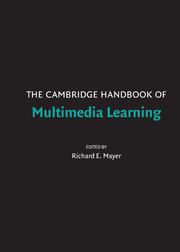Book contents
- Frontmatter
- Contents
- Preface
- Contributors
- 1 Introduction to Multimedia Learning
- PART I THEORETICAL FOUNDATIONS
- PART II BASIC PRINCIPLES OF MULTIMEDIA LEARNING
- 6 Five Common but Questionable Principles of Multimedia Learning
- 7 The Multimedia Principle
- 8 The Split-Attention Principle in Multimedia Learning
- 9 The Modality Principle in Multimedia Learning
- 10 The Redundancy Principle in Multimedia Learning
- 11 Principles for Managing Essential Processing in Multimedia Learning : Segmenting, Pretraining, and Modality Principles
- 12 Principles for Reducing Extraneous Processing in Multimedia Learning : Coherence, Signaling, Redundancy, Spatial Contiguity, and Temporal Contiguity Principles
- 13 Principles of Multimedia Learning Based on Social Cues : Personalization, Voice, and Image Principles
- PART III ADVANCED PRINCIPLES OF MULTIMEDIA LEARNING
- PART IV MULTIMEDIA LEARNING IN CONTENT AREAS
- PART V MULTIMEDIA LEARNING IN ADVANCED COMPUTER-BASED CONTEXTS
- Author Index
- Subject Index
- References
9 - The Modality Principle in Multimedia Learning
Published online by Cambridge University Press: 05 June 2012
- Frontmatter
- Contents
- Preface
- Contributors
- 1 Introduction to Multimedia Learning
- PART I THEORETICAL FOUNDATIONS
- PART II BASIC PRINCIPLES OF MULTIMEDIA LEARNING
- 6 Five Common but Questionable Principles of Multimedia Learning
- 7 The Multimedia Principle
- 8 The Split-Attention Principle in Multimedia Learning
- 9 The Modality Principle in Multimedia Learning
- 10 The Redundancy Principle in Multimedia Learning
- 11 Principles for Managing Essential Processing in Multimedia Learning : Segmenting, Pretraining, and Modality Principles
- 12 Principles for Reducing Extraneous Processing in Multimedia Learning : Coherence, Signaling, Redundancy, Spatial Contiguity, and Temporal Contiguity Principles
- 13 Principles of Multimedia Learning Based on Social Cues : Personalization, Voice, and Image Principles
- PART III ADVANCED PRINCIPLES OF MULTIMEDIA LEARNING
- PART IV MULTIMEDIA LEARNING IN CONTENT AREAS
- PART V MULTIMEDIA LEARNING IN ADVANCED COMPUTER-BASED CONTEXTS
- Author Index
- Subject Index
- References
Summary
Abstract
The capacity limitations of working memory are a major impediment when students are required to learn new material. Furthermore, those limitations are relatively inflexible. Nevertheless, in this chapter we explore one technique that can effectively expand working memory capacity. Under certain, well-defined conditions, presenting some information in visual mode and other information in auditory mode can expand effective working memory capacity and so reduce the effects of an excessive cognitive load. This effect is called the modality effect or modality principle. It is an instructional principle that can substantially increase learning. This chapter discusses the theory and data that underpin the principle and the instructional implications that flow from the principle.
Introduction
There is evidence to indicate that the manner in which information is presented will affect how well it is learned and remembered (e.g., Mayer, Bove, Bryman, Mars, & Tapangco, 1996). This chapter deals with evidence documenting the importance of presentation modes, specifically the modality effect that occurs when information presented in a mixed mode (partly visual and partly auditory) is more effective than when the same information is presented in a single mode (either visual or auditory alone). The instructional version of the modality effect derives from the split-attention effect (see chapter 8), a phenomenon explicable by cognitive load theory (see chapter 2). It occurs when multiple sources of information that must be mentally integrated before they can be understood have written (and therefore visual) information presented in spoken (and therefore auditory) form.
- Type
- Chapter
- Information
- The Cambridge Handbook of Multimedia Learning , pp. 147 - 158Publisher: Cambridge University PressPrint publication year: 2005
References
- 86
- Cited by

